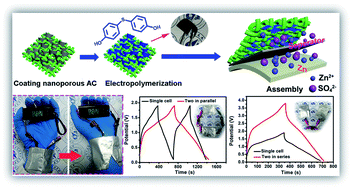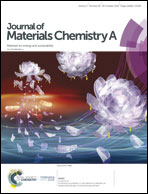A high-capacity aqueous Zn-ion hybrid energy storage device using poly(4,4′-thiodiphenol)-modified activated carbon as a cathode material†
Abstract
Aqueous electrochemical energy storage devices have advantages in terms of high safety, low cost, and environmental benignity, yet a major drawback is the low energy density compared to those using organic electrolytes. Here, we report an aqueous Zn-ion hybrid energy storage device (ZIHESD) using poly(4,4′-thiodiphenol, TDP)-modified nanoporous activated carbon (AC) as the cathode material. The introduction of this redox-active polymer can largely enhance the energy storage capacity. Compared to the Zn//AC cell, the use of the poly(4,4′-TDP)/AC cathode leads to not only a wide voltage window, as broadened from 0.2–1.8 V to 0.1–1.9 V, but also an approximately three-fold increased areal capacity. The capacity retention is 71% after 2000 cycles. Also, a group of ZIHESDs with different AC mass loadings in the cathode are tested. A maximum areal capacity of 1.16 mA h cm−2 is achieved. Furthermore, a flexible quasi-solid-state cell encapsulated in a flat pouch shows stable electrochemical performance when repeatedly bent at large angles. The cell shows sustained powering capability after being partially cut by using scissors. The energy storage mechanism is discussed in detail.



 Please wait while we load your content...
Please wait while we load your content...